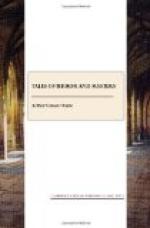“Whatever may be the truth,” said he, “it must depend upon some bizarre and rare combination of events, so we need have no hesitation in postulating such events in our explanation. In the absence of data we must abandon the analytic or scientific method of investigation, and must approach it in the synthetic fashion. In a word, instead of taking known events and deducing from them what has occurred, we must build up a fanciful explanation if it will only be consistent with known events. We can then test this explanation by any fresh facts which may arise. If they all fit into their places, the probability is that we are upon the right track, and with each fresh fact this probability increases in a geometrical progression until the evidence becomes final and convincing.
“Now, there is one most remarkable and suggestive fact which has not met with the attention which it deserves. There is a local train running through Harrow and King’s Langley, which is timed in such a way that the express must have overtaken it at or about the period when it eased down its speed to eight miles an hour on account of the repairs of the line. The two trains would at that time be travelling in the same direction at a similar rate of speed and upon parallel lines. It is within every one’s experience how, under such circumstances, the occupant of each carriage can see very plainly the passengers in the other carriages opposite to him. The lamps of the express had been lit at Willesden, so that each compartment was brightly illuminated, and most visible to an observer from outside.
“Now, the sequence of events as I reconstruct them would be after this fashion. This young man with the abnormal number of watches was alone in the carriage of the slow train. His ticket, with his papers and gloves and other things, was, we will suppose, on the seat beside him. He was probably an American, and also probably a man of weak intellect. The excessive wearing of jewellery is an early symptom in some forms of mania.
“As he sat watching the carriages of the express which were (on account of the state of the line) going at the same pace as himself, he suddenly saw some people in it whom he knew. We will suppose for the sake of our theory that these people were a woman whom he loved and a man whom he hated—and who in return hated him. The young man was excitable and impulsive. He opened the door of his carriage, stepped from the footboard of the local train to the footboard of the express, opened the other door, and made his way into the presence of these two people. The feat (on the supposition that the trains were going at the same pace) is by no means so perilous as it might appear.




